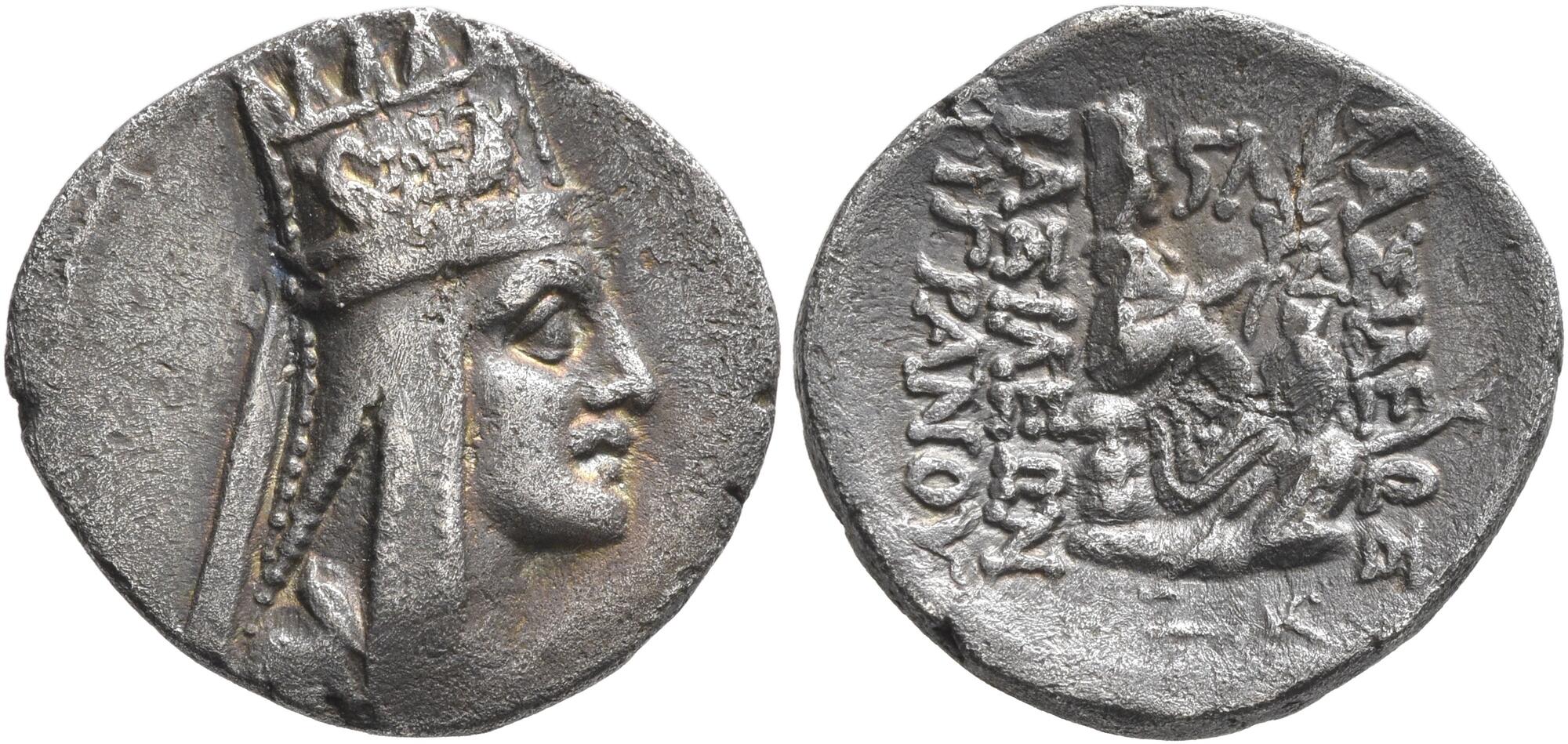S 97 - Artaxata (Tigranes II), silver, drachms (78-72 BCE)
From SILVER
78 BCE - 72 BCE Silver 3,862 kg
Description
| ObverseInscription or printing placed on the obverse.: | Draped bust of Tigranes II to right, wearing five-pointed tiara decorated with comet star between two eagles |
| ReverseInscription or printing placed on the reverse.: | ΒΑΣΙΛΕΩΣ ΒΑΣΙΛΕΩN TIΓΡΑΝΟΥ (Greek).Tyche of Antioch or Artaxata seated on a rock to right, wearing a mural crown and a long tunic, holding a palm in the right hand. At her feet, the river Orontus personified three quarter right, head facing. Between the palm and the head of Tyche, a date. At the exergue, ΞK or ΞC. All within a laurel wreath. |
Mint and issuing power
| MintIdentifies the place of manufacture or issue of a numismatic object.: | Artaxata | Ancient regionAncient region.: | Armenia | Modern countryModern country: Armenia | AuthorityIdentifies the issuing power. The authority can be "pretended" when the name or the portrait of X is on the coin but he/she was not the issuing power. It can also be "uncertain" when there is no mention of X on the coin but he/she was the issuing power according to the historical sources: | Tigranes II of Armenia (Artaxiad king, c. 95-56 BC), Armenian kingdom |
Chronology
| FromIdentifies the initial date in a range assigned in a numismatic context. | 78 BCE | toIdentifies the final date in a range assigned in a numismatic context.. | 72 BCE | PeriodTime period of the numismatic object.: Hellenistic 323-30 BC |
Physical description
| MetalThe physical material (usually metal) from which an object is made.: | Silver |
Median weightMedian of the weights of numismatic objects (in grams). in grams | 3.80 | DenominationTerm indicating the value of a numismatic object. Examples: tetradrachm, chalkous, denarius.: | drachma |
StandardStandard.: | Attic |
Image

S97 Tigranes Artaxata drachms.jpg [1]
References
| Die study referencePublication of the study: | Nercessian 20061Nercessian 2006, p. 87-102 | ||
| Coin series referenceReference to coin series study: | Sear II2Sear II, n° 7204 | ||
Obverse dies distribution
| FrequencyFrequency of specimen in distribution. ᵖ | Number of obversesNumber of obverse dies. ᵖ (o) | % (o) | Number of coinsNumber of coins. (n) | % (n) | Die nameName(s) of the die(s). |
| 1 | 18 | 42.86 | 18 | 12.33 | 1, 4, 5, 13, 14, 16, 19, 24, 26, 27, 28, 34, 35, 38, 39, 40, 41, 42 |
| 2 | 6 | 14.29 | 12 | 8.22 | 6, 15, 17, 18, 23, 25 |
| 3 | 3 | 7.14 | 9 | 6.16 | 2, 7, 32 |
| 4 | 4 | 9.52 | 16 | 10.96 | 11, 20, 33, 36 |
| 5 | 3 | 7.14 | 15 | 10.27 | 12, 22, 30 |
| 6 | 3 | 7.14 | 18 | 12.33 | 3, 10, 31 |
| 7 | 1 | 2.38 | 7 | 4.79 | 8 |
| 8 | 1 | 2.38 | 8 | 5.48 | 21 |
| 11 | 1 | 2.38 | 11 | 7.53 | 29 |
| 12 | 1 | 2.38 | 12 | 8.22 | 37 |
| 20 | 1 | 2.38 | 20 | 13.7 | 9 |
| Total | 42 of 42 | 99.99 | 146 of 146 | 99.99 |
Reverse dies distribution
no distribution is available
Quantification
| Number of obversesNumber of obverse dies. ᵖ (o) | 42 | Number of singletons (o1)The number of singleton coins. ᵖ | 18 |
| Number of reverse diesNumber of reverse dies. (r) | 96 | Number of coinsNumber of coins. (n) | 146 |
| Coins per obverse dieNumber of coins per obverse die. (n/o) | 3.48 | Coins per reverse dieNumber of coins per reverse die. (n/r) | 1.52 |
| Reverse per obverse ratioRatio of obverse dies divided by reverse dies. (r/o) | 2.29 | Percentage of singletons (o1)number of coins (n) divided by the number of singletons (o1) ᵖ | 42.86 % |
| Original number of dies (O) (Carter 1983 formula)The estimation of the number of coins according to Carter 1983 ᵖ | 50.82 | Coins struck if 20,000 as average productivity per dieCoins made if the average productivity for obverses (according to Carter) is 20,000. ᵖ | 1,016,400 |
| Original number of dies (O) (Esty 2011 formula)The estimation of the number of coins according to the singleton formula in Esty 2011 ᵖ (O) | 58.96 | Survival rate if 20,000 as average productivity per dieSurvival rate if average productivity is 20,000. ᵖ | 0.00014 |
| Coverage (o = % of O) (Esty 1984 formula)Esty 1984 - coverage (% of O) ᵖ (o = % of O) | 87.67% | Die productivity if survival rate 1/2,000Average productivity if survival rate is 1/2,000. ᵖ | 5,745.77 |
| Weight of silver (in kg) if 20,000 coins per die (O = Carter formula)Carter 1983 * Median weight * 20000 (*10 if gold or electrum) ᵖ | 3,862 kg <br /> 3,862 kg | Die productivity if survival rate 1/5,000Average productivity if survival rate is 1/5,000. ᵖ | 14,364.42 |
Remarks